Entrance Garden and Brick Path
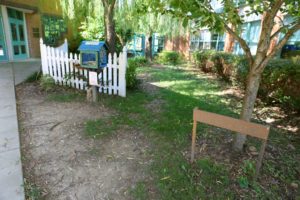 The Entrance Garden was designed to be a welcoming area for people, bees and butterflies. It provides a
The Entrance Garden was designed to be a welcoming area for people, bees and butterflies. It provides a 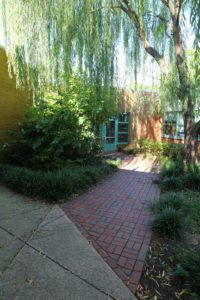 quiet sitting area and a place to contemplate nature. Two Weeping Willows and Flowering Cherry provide shady areas and seasonal color. Witch Hazel provides bright yellow flowers for study in the late winter while an Abelia and Virginia Sweetspire hedge buzzes with activity during early spring and summer. A white picket fence, typical of Colonial times, helps create the feeling of sanctuary and quiet reflection. Names of donors to our early building projects are featured in the bricks that form a path in this garden area.
quiet sitting area and a place to contemplate nature. Two Weeping Willows and Flowering Cherry provide shady areas and seasonal color. Witch Hazel provides bright yellow flowers for study in the late winter while an Abelia and Virginia Sweetspire hedge buzzes with activity during early spring and summer. A white picket fence, typical of Colonial times, helps create the feeling of sanctuary and quiet reflection. Names of donors to our early building projects are featured in the bricks that form a path in this garden area.
Virginia Colonial Garden
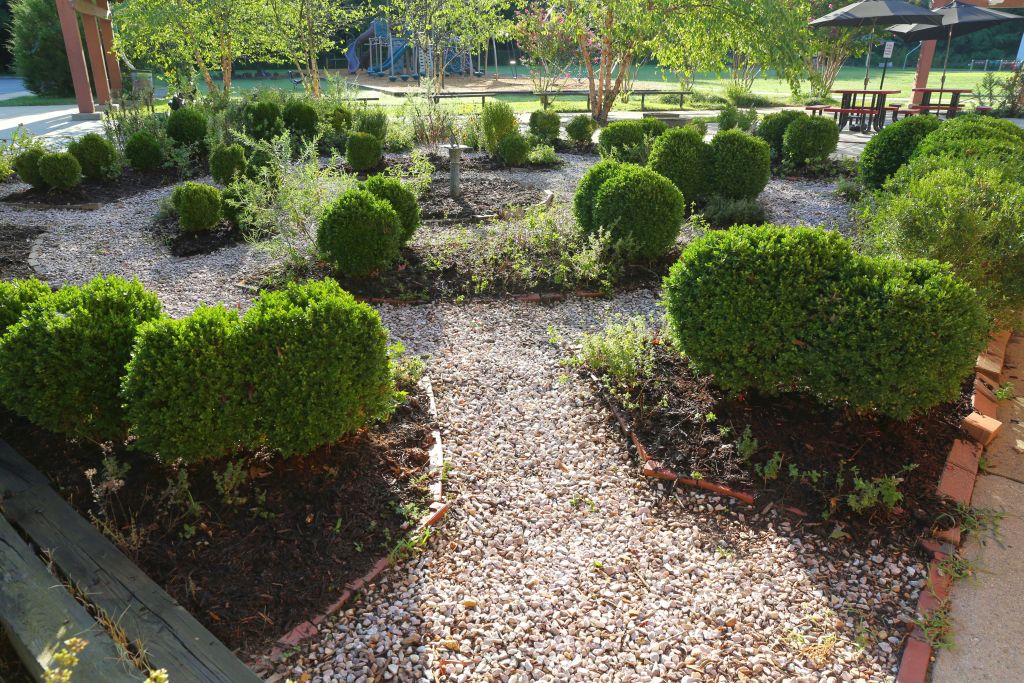 This formal garden might have been in the yard of a wealthy family during the colonial period in Virginia’s history. Researched and designed by the 4thand 5thgrade, the garden is symmetrical with paths of white gravel to mimic the colonial crushed oyster shells. The traditional sundial in the center is surrounded by roses, rosemary, mint and sage.
This formal garden might have been in the yard of a wealthy family during the colonial period in Virginia’s history. Researched and designed by the 4thand 5thgrade, the garden is symmetrical with paths of white gravel to mimic the colonial crushed oyster shells. The traditional sundial in the center is surrounded by roses, rosemary, mint and sage.
Cash Crop Garden
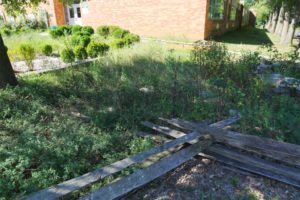 Adjacent to the Virginia Colonial Garden, this garden represents a “kitchen garden” or “cash crop” (corn, cotton, tobacco) garden grown by hardworking farmers during the colonial period. Raspberries and blackberries are planted next to the split rail fence (a commonly used fence in Colonial times). The stone wall was installed to reduce soil erosion. Over the years different classes have planted in this area for a variety of purposes.
Adjacent to the Virginia Colonial Garden, this garden represents a “kitchen garden” or “cash crop” (corn, cotton, tobacco) garden grown by hardworking farmers during the colonial period. Raspberries and blackberries are planted next to the split rail fence (a commonly used fence in Colonial times). The stone wall was installed to reduce soil erosion. Over the years different classes have planted in this area for a variety of purposes.
Pathway Garden
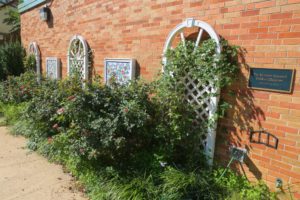 This narrow garden alongside the building across the path from the Colonial Garden was initially planted as a “Slave Garden,” made up of the vegetables (greens, beans, gourds, and squash) that slaves may have grown to supplement their food allowances. Over the years this space has been transformed into a garden of flowers and vegetables.
This narrow garden alongside the building across the path from the Colonial Garden was initially planted as a “Slave Garden,” made up of the vegetables (greens, beans, gourds, and squash) that slaves may have grown to supplement their food allowances. Over the years this space has been transformed into a garden of flowers and vegetables.
Elizabeth Campbell Outdoor Classroom Patio
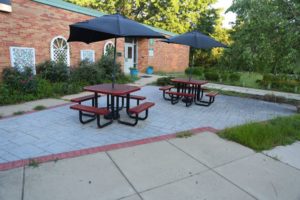 The patio was designed to provide an outdoor space for students to work, and a place for the community to have lunch and socialize. The rose mosaics (Mrs. Campbell’s favorite flowers) were designed by an art teacher, and produced with students and parents. Knock out roses were planted because no chemicals are required to maintain them. River Birches, a native species used by Native Americans for a variety of purposes, flourish in this area due to the high water table on the property.
The patio was designed to provide an outdoor space for students to work, and a place for the community to have lunch and socialize. The rose mosaics (Mrs. Campbell’s favorite flowers) were designed by an art teacher, and produced with students and parents. Knock out roses were planted because no chemicals are required to maintain them. River Birches, a native species used by Native Americans for a variety of purposes, flourish in this area due to the high water table on the property.
The Meandering Path and Features Around It
Laurie Baker Lane
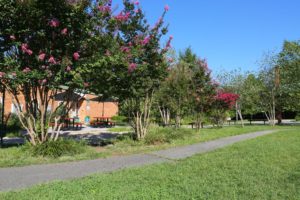 The paved path once circling the field is named after the school’s first principal, Laurie Baker. Funding for construction of the path and the two sheds housing tricycles, scooters and shovels was acquired through several grants from the Arlington Forest Foundation. The sheds were constructed as part of an Eagle Scout project. The path was disrupted by the installation of the new playground and is scheduled to be fixed.
The paved path once circling the field is named after the school’s first principal, Laurie Baker. Funding for construction of the path and the two sheds housing tricycles, scooters and shovels was acquired through several grants from the Arlington Forest Foundation. The sheds were constructed as part of an Eagle Scout project. The path was disrupted by the installation of the new playground and is scheduled to be fixed.
The Field
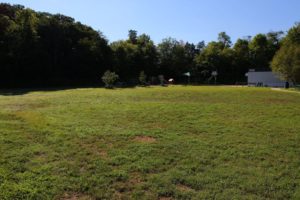 Students continue to learn even during play. Whole group activities and sports like the ever popular game of soccer are played enthusiastically on the large grassy expanse. Classes occasionally use this area for movement activities and science studies. The annual Campbell Olympic Games use this field for many of the fun and engaging physical activities that make up this celebratory day.
Students continue to learn even during play. Whole group activities and sports like the ever popular game of soccer are played enthusiastically on the large grassy expanse. Classes occasionally use this area for movement activities and science studies. The annual Campbell Olympic Games use this field for many of the fun and engaging physical activities that make up this celebratory day.
The Blacktop
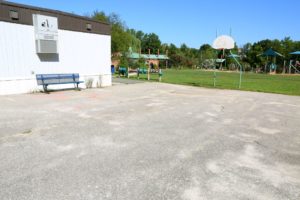 Some activities just need a good, hard surface, such as ball bouncing, basketball, chalk drawing, and tricycle riding.
Some activities just need a good, hard surface, such as ball bouncing, basketball, chalk drawing, and tricycle riding.
Rain Barrels
During the Kindergarten/1st Grade Expedition “The Earth Beneath Our Feet,” a local gardener/artist Corinne DeJesus visited and discussed the purpose of rain barrels: water storage, prevention of run-off into streams, and recycling water. Later, she painted the barrels with resident animals suggested by the K/1 classes. Water from the rain barrels is used to water the plantings along the “snake fence” bordering the parking area. A third rain barrel has been added near the school’s entrance. This was painted by students under the direction of a former Campbell art teacher and won an award at George Mason University.
The Trellis/Arch
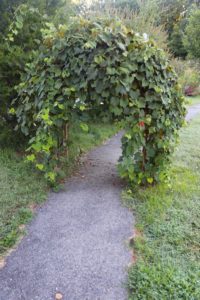 A Concord grape vine grows over the arch.
A Concord grape vine grows over the arch.
Pollinator Garden
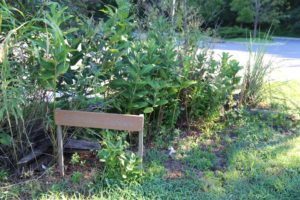 The 3rd grade Bee Expedition led students to research plant species of annual and perennial plants that are attractive to bees. Bee balm, salvia, lavender, cone flowers, sunflowers, butterfly bush, and ornamental grasses are some of the plants currently growing in this area.
The 3rd grade Bee Expedition led students to research plant species of annual and perennial plants that are attractive to bees. Bee balm, salvia, lavender, cone flowers, sunflowers, butterfly bush, and ornamental grasses are some of the plants currently growing in this area.
The Amphitheater
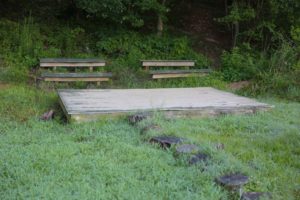 At the eastern edge of the playground near the stairs to South 7th Street, a raised platform and rows of benches provide the perfect stage for dramatic play or special presentations.
At the eastern edge of the playground near the stairs to South 7th Street, a raised platform and rows of benches provide the perfect stage for dramatic play or special presentations.
The Butterfly Garden
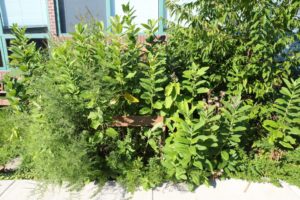 Between the school building and the sidewalk lies a butterfly garden. It is lush with plants that attract butterflies by providing nectar to the adults, and food for the growing caterpillars. As in the other gardens on campus, the plants are a mix of native and non-native species. The goal is to use more and more native and historically significant species throughout the schoolyard.
Between the school building and the sidewalk lies a butterfly garden. It is lush with plants that attract butterflies by providing nectar to the adults, and food for the growing caterpillars. As in the other gardens on campus, the plants are a mix of native and non-native species. The goal is to use more and more native and historically significant species throughout the schoolyard.
Additional Areas
The Orchard
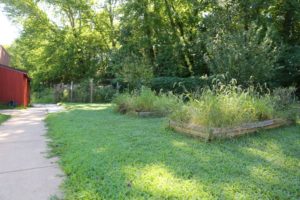 Several K/1 classrooms open into this area which is home to heritage apple trees (some of the same varieties as planted by Thomas Jefferson at Monticello). Each classroom has a raised bed just outside the door which is used for class vegetable and flower gardens. Bachelor buttons attract American Goldfinches, and spring bulbs delight us all with their bright colors.
Several K/1 classrooms open into this area which is home to heritage apple trees (some of the same varieties as planted by Thomas Jefferson at Monticello). Each classroom has a raised bed just outside the door which is used for class vegetable and flower gardens. Bachelor buttons attract American Goldfinches, and spring bulbs delight us all with their bright colors.
The Courtyard
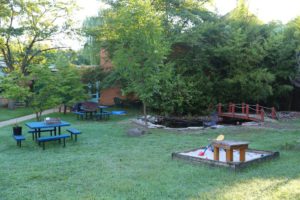 Like an oasis in the middle of the school building, the Courtyard is completely enclosed providing a quiet location for both guided explorations and relaxation. A trickling pond quickly draws the attention of visitors, as well as habitat for plants, mushrooms, algae, and many animals, including box turtles, and red eared sliders. Yearly we discover visitors such as mallard ducks looking for spring nesting sites. The rich soil in our raised micro-climate beds
Like an oasis in the middle of the school building, the Courtyard is completely enclosed providing a quiet location for both guided explorations and relaxation. A trickling pond quickly draws the attention of visitors, as well as habitat for plants, mushrooms, algae, and many animals, including box turtles, and red eared sliders. Yearly we discover visitors such as mallard ducks looking for spring nesting sites. The rich soil in our raised micro-climate beds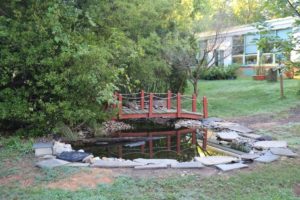 soaks up the warmth reflected off the brick buildings allowing our vegetable and flower gardens to thrive for a longer growing season. Composting of plant scraps and leaves helps us maintain the rich soil, enhancing student food crops grown for donation to our local food banks. Tables and benches provide seating for students and teachers alike during lessons or lunches. A large storage shed houses our collection of gardening tools.
soaks up the warmth reflected off the brick buildings allowing our vegetable and flower gardens to thrive for a longer growing season. Composting of plant scraps and leaves helps us maintain the rich soil, enhancing student food crops grown for donation to our local food banks. Tables and benches provide seating for students and teachers alike during lessons or lunches. A large storage shed houses our collection of gardening tools.
Future Developments
Campbell Elementary School is always seeking ways to better utilize our natural resources and our community talents! We welcome collaborative expertise and creativity in the development of these possible additions:
Physical Improvements:
- Places for quiet reading
- Interpretive signage related to our outdoor classroom spaces and gardens
- Additional shaded areas
- A reliable watering system
- An interactive school yard bulletin board
Relationships with People:
- Partnering with mentor-volunteers through a local garden club
- A student gardening club
- Organized real-life application of curriculum into the use of the campus, such as using math to calculate the distances in our playground
Ways You Can Contribute
- Donate your time by showing up on one of our Saturday Gardening days or volunteering to help organize and implement special events related to our Outdoor Classrooms
- Donate your talents (mentor gardener, landscape design, graphic artistry in signage development, etc)
- Donate funds or materials for new and on-going projects, such as the Wetland Learning Lab
 Contact
Contact  Calendars
Calendars Careers
Careers Engage
Engage  District
District
